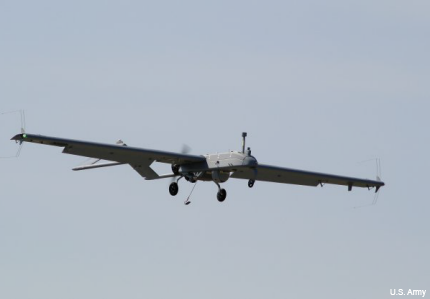Army equips first combined Shadow/Apache unit
The move puts control of manned and unmanned operations under one roof as part of the service's restructuring plan.

The RQ-7Bv2 (Tactical Common Data Link) Shadow unmanned aircraft system.
release.
To date, manned and unmanned operations have been performed cooperatively but separately, with units operating under separate commands. Under ARI, the Army is planning to assign units to both manned and unmanned assets in order to make operations more seamless.
The RQ-7B Shadow, manufactured by Textron Systems, is a catapult-launched aircraft with a wingspan of 20 feet and a payload of 60 pounds used to provide ISR, security; cooperative attack; battle damage assessment; and communications relay support to the brigade, according to the Army.
New capabilities of the Shadow v2 include:
• Encryption protection on the video and control data links.
• Software enhancements allowing interoperability between Army UAS platforms, which ultimately will enable a Shadow operator to control the extended-range Gray Eagle UAS, and vice versa.
• Integrates a common control station and control terminal for all Army UAS platforms, which will increase commonality, interoperability and reduce life cycle costs.
• Standardizes the Shadow fleet to a single configuration which reduces life cycle costs.
• Increased endurance of the Shadow aircraft, increasing the enduring from six to nine hours.
ARI, approved by Army Chief of Staff Gen. Ray Odierno in 2013, is a plan to keep the Army’s aviation force effective as it grows smaller because of funding reduction. It has been proved to be controversial because it would cut several aviation programs and aircraft in the name of modernization and cost savings.
One point of the controversy is that it would take Apache helicopters away from the Army National Guard, Breaking Defense has reported. The Army will replace rotary wing aircraft with a mix of unmanned aircraft and Apache helicopters. Aside plans to buy 225 rotary wing aircraft, if funds are available, the Army also wants to buy 15 new Grey Eagle unmanned aircraft, Breaking Defense reported. The Grey Eagle is the Army’s version of the Air Force’s Predator drone.
Following the release of the Army’s budget earlier this year, Davis Welch, Deputy Director of Army Budget, told reporters at the Pentagon in a briefing that ARI “retain[s] the most modernized aircraft while divesting models -- all models of the legacy, single-engine aircraft. The plan equips reconnaissance and attack units with the AH-64 Echo Model Apache, chained with Gray Eagle or Shadow unmanned aerial vehicles. ARI also equips the training base with the Lakota helicopter in lieu of the legacy TH-67 Creek helicopter.” If approved, the budget would complete that transition, he said.
Those controversies aside, the Army is planning to move forward with integrating manned and unmanned operations. "This merging is really about the soldier on the ground.” Lt. Col. RJ Garcia, commander of the 3rd Squadron, 6th Cavalry Regiment, said in reference to the transition within the 1/501st. “We're much more efficient, lethal and effective. We're going to build on the great things that soldiers across multiple organizations within the U.S. Army have done to be better."
Garcia also applauded manned and unmanned aircraft teaming, noting that the Shadow and Apache have favorable combat records. “It's an improved capability that supports them as they execute the various missions that we assign them. Nothing is stove-piped now. We now have the ability to share across multiple levels," he said.
This increased sharing was addressed in the Army’s UAS Roadmap for 2010-2035. While operational needs for soldiers during the Iraq and Afghanistan wars pushed policy and UAS integration in combat situations, the haste to accommodate these needs contributed to “a relatively disjointed, limited, and stove-piped UAS effort,” according to the roadmap. The Shadow was part of that quick response, which neglected interoperability between UAS platforms. With the Army’s new Shadow v2, operators will be trained in multiple systems.
The Army also recently awarded Textron Systems a $79.5 million contract to procure additional Shadow UAS’s according to Military & Aerospace. Additionally, the Army’s aviation budget, released this year, includes $81.4 million for production of four Shadow v2 retrofits in fiscal 2016.